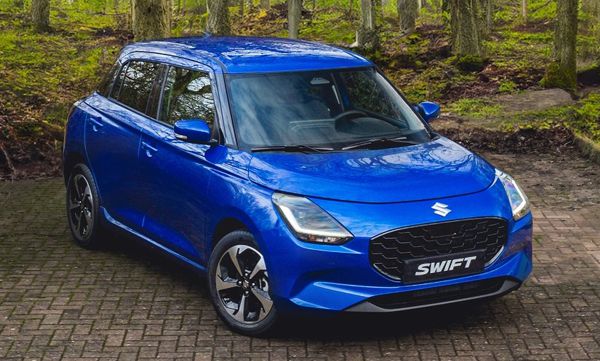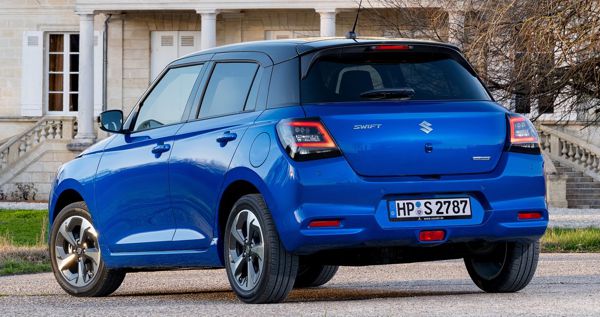Published
on 8
May 2024
|
All rights reserved.
|
|
|

|
|
Swift
stays true to the essence of superminis – affordable, practical and fun
to drive.
|
|
Swift
is Suzuki’s only global small car, having presence in Japan, Europe,
India and ASEAN countries. According to FY2022 sales figures, it is the
company’s second best-selling model with 338,000 units, trailing only
the smaller Alto. The car is built in mainly Japan and India, with the
former supplying European market.
Swift is always a likeable small car. Cult looks, fun driving manner
and keen pricing are its obvious strengths. It is slightly smaller than
most European superminis, but still offers comparable or better
interior space thanks to Suzuki’s expertise in designing K-cars. This
remains true to the latest iteration.
The Swift nameplate has been in use since 1985. I still remember the
GTi version of that car, powered by a 1.3-liter 16V engine producing a
remarkable 100 hp, was referred to “Small Chili”. The second generation
model with glassy packaging was equally impressive. Then came the 2005
generation, which is reckoned to be the true farther of subsequent
Swifts. It raised the bar higher with great styling and handling. It
was also the first global Swift, expanding sales to Europe for the
first time. The 2010 and 2017 generations just followed the template
set by that car.
The latest generation was launched in Japan December last year. It is
not a full makeover, but more a repackaging and update job. The
hardpoints of the 2017 car are kept untouched, so are all key
dimensions such as the 2450mm wheelbase and 1735mm width. Length is
extended by 20mm thanks to that Maserati-style nose, but at 3860mm it
remains shorter than European superminis – rivals like Renault Clio,
Skoda Fabia, Peugeot 208 and Opel Corsa all exceed 4 meters.

|
|
3-pot
engine sacrifices some revs and power for complying with emission
standards.
|
|
While
the shape is familiar, there are changes in the design details to make
the Swift up to date. The pronounced and slightly octagonal shaped
front grille is a key change, as are the headlights and a clamshell
bonnet. A sharp crease line is pressed onto each shoulder. The
C-pillars are now completely blackened so that the “floating roof”
effect even more obvious. Moreover, you can now opt for two-tone color
scheme with the roof blackened as well.
Inside, the dashboard and door panels have been redesigned. To keep
cost low, old-school analogue instrument is retained (why not?), but
the center console is overhauled. Touchscreen has been moved upward,
standing freely above the dash for easier view and access. Fortunately,
air-con and safety assistance features are still controlled by physical
switches beneath the air vents. The touchscreen infotainment system is
pretty basic, but wireless connectivity is standard, as is the suite of
advanced safety systems like adaptive cruise control, lane keep assist,
traffic sign recognition and driver monitoring.
Are the materials and build quality improved? Slightly, but nowhere
near the level of any European counterparts. Most of the plastics in
cabin are still hard and scratchy and sound hollow.
Never mind, because the Swift remains cheap to buy and highly practical
to live with. Despite a wheelbase shorter than European rivals by about
100mm, the Swift offers remarkable rear seat legroom. It can
accommodate a six-footer behind another six-footer, something a larger
Peugeot 208 struggles to do. The only downside is luggage space, which
is only 265 liters, but that is to be expected.
The new car keeps the “Heartect” chassis of its predecessor. It uses
curvy longitudinal members and fewer connecting points to achieve
weight reduction. Although the latest improvement to NVH, safety and
equipment features add around 80 kg to its weight, the car is still
comfortably less than 1000 kg, noticeably lighter than its European
rivals. There are some refinements to suspension design, such as
thicker front anti-roll bar and longer rear suspension travel. The
chassis uses more structural adhesives, damping sheets on floor and
hydraulic engine mounts. Aerodynamics is also refined slightly.

|
|
It
can accommodate a six-footer behind another six-footer, something a
larger Peugeot 208 struggles to do.
|
|
Entirely new
is the engine. While the old car offered a choice of 1.2-liter Dualjet
4-cylinder and 1.0-liter Boosterjet 3-cylinder turbo, the new car
settles with one and only one 1.2-liter 3-cylinder naturally aspirated
unit with codename Z12E. It is obviously designed for efficiency and
helps Suzuki to comply with the very stringent fleet CO2
emission limit in Europe. 74mm bore and 92.8mm stroke are chosen to
enhance torque at the cost of top end power, so the latter drops by 9hp
to 82hp, a rather significant reduction. It is mated with a standard
mild-hybrid system to allow 99g/km CO2
emission. To keep cost low, the mild-hybrid employs a 12V integrated
starter generator and a very small battery, offering a boost of only
3hp – yes, three horsepower – and 44 lbft of torque under acceleration.
Because of the enhanced mid-range torque, the car doesn’t feel
noticeably slower in real world driving, but stretch its muscles on
straight and you will find the new 3-cylinder loses the enthusiasm for
rev compared with the outgoing 1.2 Dualjet four-pot, and this reflects
on stop watch: 0-60 mph takes 0.6 seconds longer to achieve, while top
speed dips from 112 to merely 103 mph. Some sparkles of the old car has
been lost.
At the moment there is no official word about the hot version Swift
Sport, but rumors said it is likely to retain the 1.4-liter turbo motor
from the last generation.
The 5-speed manual gearbox is generally slick and pleasurable to shift.
Thanks to relatively lightweight and compact dimensions, the Swift
feels agile and even fun to drive in the twisty. Its ride is not too
firm, actually more comfortable than a Toyota Yaris, Hyundai i20 or
Mazda 2 if not some European rivals, yet the car doesn’t display a lot
of body roll through corners. Just a hint of roll and it settles
quickly on its suspension. The steering is well-weighted and linear.
The balance is good. This chassis bolds well for the upcoming Swift
Sport.
After so many years, it is nice to see the Suzuki Swift still lives on,
and lives on its own way. It refuses to chase growing size, upmarket
packaging or pseudo SUV flavors, staying true to the essence of
superminis – affordable, practical and fun to drive.
|
Verdict:     |
|